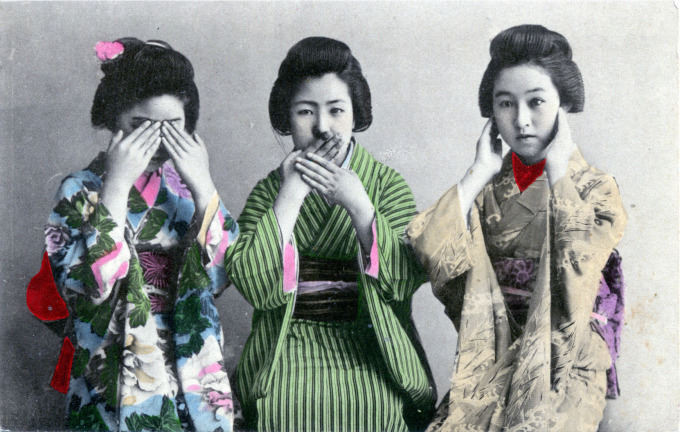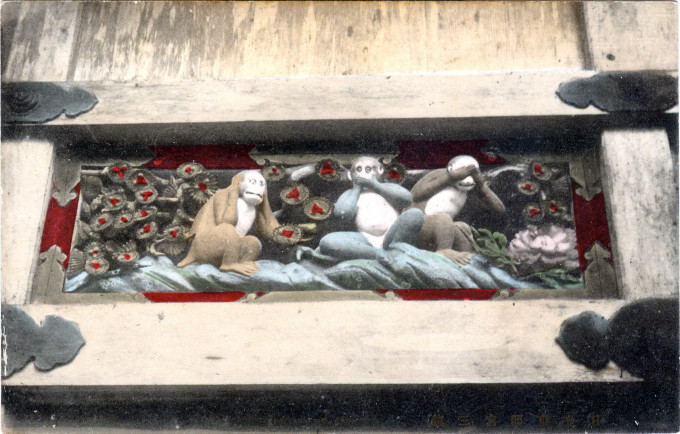
Three onnanoko (pretty maidens) replicate the Japanese saying “See no evil, speak no evil, hear no evil.”
See also:
Nikko, Japan, c. 1910
Oumaya (Sacred Horse Stable), Nikko, c. 1920
“Koshin stones in the precinct of Tokyo reveal three seated monkeys as stated above. According to Meider, they ‘represent the Japanese expression ‘mi-zaru, kika-zaru, iwa-zaru, or ‘not seeing, not hearing, not speaking,’ in which the Japanese word zaru can also be associated with the word for monkey saru, giving us perhaps a linguistic clue to why it is three gesturing monkeys being portrayed.
“The first English reference to the three monkeys proverb appeared in 1884 in an English travelers’ handbook to Japan … A reference in the British Army & Navy Stores catalog [1926] demonstrates the carvings were being marketed commercially. Florence Boyce David (1873-1938), a Vermont poet, published a four-stanza didactic poem about the three monkeys with an illustration in a children’s magazine [1922], reprinted five years later in a popular anthology.”
– Folkloristics: An Introduction, Robert A. Georges, 1995
From the wiki: “The three wise monkeys, sometimes called the three mystic apes, are a pictorial maxim. Together they embody the proverbial principle to ‘see no evil, hear no evil, speak no evil’. The three monkeys are Mizaru, covering his eyes, who sees no evil; Kikazaru, covering his ears, who hears no evil; and Iwazaru, covering his mouth, who speaks no evil. Sometimes there is a fourth monkey depicted with the three others; the last one, Shizaru, symbolizes the principle of ‘do no evil’. He may be shown crossing his arms or covering his genitals.
“The source that popularized this pictorial maxim is a 17th-century carving over a door of the famous Tōshō-gū shrine in Nikkō, Japan. The carvings at Toshogu Shrine were carved by Hidari Jingoro, and believed to have incorporated Confucius’s Code of Conduct, using the monkey as a way to depict man’s life cycle.
“There are a total of 8 panels, and the iconic three wise monkeys picture comes from panel 2. The philosophy, however, probably originally came to Japan with a Tendai-Buddhist legend, from China in the 8th century (Nara Period). It has been suggested that the figures represent the three dogmas of the so-called middle school of the sect.”



Pingback: Oumaya (Sacred Horse Stable) of Toshogu, Nikko, c. 1920. | Old Tokyo
Pingback: Nikko, Japan, c. 1910. | Old Tokyo
Pingback: Kimono fashion, c. 1910. | Old Tokyo